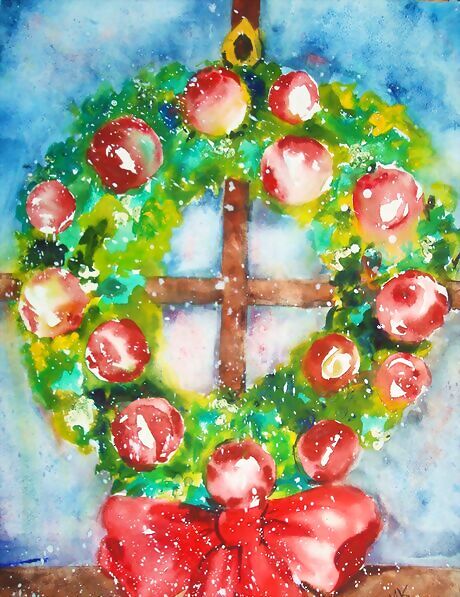
views

Decide which orientation you wish to hold your watercolor paper. Lightly sketch a large circle in pencil, filling the space. Plan to reserve enough area around the circle to paint greenery without having it look squashed. Keep in mind to allow small white borders around the wreath, too.
Study wreaths online because they come in many styles. A classic is a round wreath made of greenery and adorned with small, colored ornaments. A large bow is another common addition.
Lightly sketch an inner circle and an outer circle to represent the space the greenery will fill and to use as a guide when you paint.
Lightly plot placement for ornaments on the wreath's surface. Do this using a circle template or draw around lids from small bottles or jars.

Sketch a large, generous bow at the top or bottom of the wreath. Allow room for the tails of the bow so they don’t appear crushed or squeezed in. This is the time (while you are in the planning and sketching stages) to make adjustments. Then, erase unneeded lines. Practice using your pencil lightly, but with enough pressure to make your intentions clearly understood. Erasing as you go helps keep your design clean and easy to understand.
Prepare your watercolor paints by adding a small amount of water to each pad of color to activate it. You want the colors softened and ready to go. If you’re using tube watercolors, squeeze out ¼ inch of red, yellow, blue and black on a white plate or palette.
Start painting your wreath. Where should you begin painting? There is no right answer. Think of your painting as layers of sheer color that are allowed to dry thoroughly before the next glaze of color is applied. Keep in mind that for the brightest, shiny ornaments, it is a good idea to save the white of the paper by painting around those circles.
Paint the green foliage, the body of the wreath. Use the mixing part of your paint set or a white, plastic picnic plate as a palette for mixing. It will require only a dab of green because your color, when applied, should be sheer enough to have the white of the paper shine through. This is the magic of watercolor and what distinguishes it from acrylic and oil paints.
Clean the palette by wiping it with tissues. Cleanliness allows your colors to shine. Keeping the purity of each color means washing your brush thoroughly in a large amount of clean water. If the rinse water looks dirty, change it. Keep an old towel or tissues handy to wipe excess water off your brush. Paint each ornament. It is good to reserve highlights for the round, glass balls. Skip in a few places to let the white paper show through. Give your ornaments the illusion of roundness. Mix a slightly darker shade of your ornament colors and paint around the edges of each one.
Paint the bow. Try to do it freely, using direct swipes of a medium-sized pointed brush or ½ inch flat brush. Don't worry if you exceed the pencil lines you've drawn: all lines can be erased after the piece is thoroughly dry. Always try to let your brush do its thing and aim for easy-looking strokes from it.
Set the painting up and stand back. The basic color pattern is established at this point. Now think how to enrich each area, if needed, with texture and touches of deeper accent colors. The green background or foliage should be clumpy and not smooth. Adding texture and deeper green in places will give depth and make it look realistic. The ornaments can be decorated as much as you wish. Use bright, contrasting colors and a small brush to make lines, dots, squiggles and whatever patterns you wish. The bow should be puffy and stand out, so paint deeper color in what would be the areas farthest from the viewer's eye. Do a final check of all parts of the painting to make sure they are right. Perhaps you need to correct the roundness and fullness of the wreath. Check the shapes of the ornaments. Make corrections now.
Let the piece dry again. Give yourself time to distance from it, even overnight. Stand back from it and do another check of it; add any final touches where needed.

















Comments
0 comment